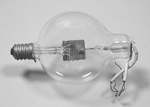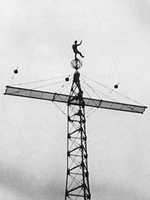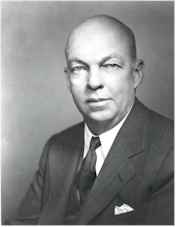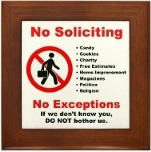|
While experimenting with his new invention, Edison understood that electrons were being boiled off of the filament. In 1883, he devised another element he called the plate to put in his light bulb that would collect the electrons that were emitted. He could induce an electrical current to flow from the filament (that he now called the emitter) through empty space to the plate.
Edison had invented the first vacuum tube, but he didn't have any idea what to use it for.
In 1904, John Fleming found a practical use for the vacuum tube. Because the current flows in both directions with alternating current (AC), he understood that what was called the "Edison effect" could be used to control current by only allowing it to pass in one direction. He called his invention the valve and first used it to convert alternating current into direct current (DC). Fleming's valve was also used by Guglielmo Marconi in the first wireless telegraph receiver.
The Audion
Lee de Forest had the idea to add a third element to the vacuum tube. He called it the grid and placed it between the emitter and the plate. He discovered that when a current is flowing between the emitter and the plate, a small signal can be applied to the grid which will be boosted in strength at the plate. The "valve" had become an amplifier and de Forest called his invention the
Audion.

The Audion Tube
The Audion made it possible to receive sound, and de Forest quickly realized the potential for broadcasting. Up until then, radio had only been used as a wireless telegraph to communicate from point-to-point"one transmitter to one receiver, but he realized that one transmitter could broadcast information and entertainment to many receivers. He was the first to start up a radio station and begin broadcasting in 1910.
There were many problems with the early broadcasts, but the biggest drawback was that the signals were very weak. Early radio enthusiasts had a lot of difficulty tuning in stations and hearing them over the background noise. The signals were too weak to drive a speaker, so people could only listen through headphones.
And Then Along Came Armstrong
Edwin Armstrong was born in 1890. During his youth in Yonkers, NY he was fascinated with the early radio broadcasts and tinkered with receiving equipment and antennas trying to improve the quality of his reception. After high school he went to Columbia to study for a degree in electrical engineering.
While still a student at Columbia, Armstrong studied the Audion and developed it to it's full potential when he discovered feedback and how to control it. He noticed that if a small portion of the amplified signal was fed back to the grid (feedback), it would pass through the grid again and again, and each time it would be amplified further. He was able to boost weak signals over 20,000 times, to the point where stations could be easily heard. People no longer had to use earphones because radios could be built with loudspeakers. He called his revolutionary design the regenerative circuit.

Armstrong's patent for the regenerative circuit
Through further experiments, Armstrong boosted the feedback signal to the point where the circuit would begin oscillating rapidly, and that generated strong electromagnetic waves. Now the Audion could be used as a radio transmitter as well as an amplifier in a receiver.
During World War I, Armstrong accepted a commission in the Army and was sent to France to develop devices that would detect enemy radio signals. He invented an 8-stage amplifier he called the superheterodyne circuit, that could reliably tune in very weak signals. After the war, he sold the rights to two of his inventions for $335,000 to Westinghouse and another amplifier design to RCA for a large amount of RCA stock.
de Forest Strikes Back
Armstrong was riding high, and then everything took a turn for the worse. Though he had received a patent for his regenerative circuit in 1914, de Forest had the audacity to apply for a patent on the same concept in 1915.
Lee de Forest wasn't much of a scientist or a businessman, but he was an opportunist. He never really understood how his Audion worked. His colleagues described his "research" as putting things together in different combinations and immediately applying for patents in the hope that he would somehow come up with something of value. de Forest was embarrassed that a young guy like Armstrong had figured the Audion out and made such important discoveries with it. He finally convinced himself that it was really he who had discovered feedback and that Armstrong had stolen the idea from him. He decided to claim the honor and profits he thought were due him, and filed a patent infringement lawsuit against Armstrong.
de Forest soon sold his patent to AT&T, who despite ample evidence to the contrary, cynically chose to believe his story that he invented the regenerative circuit first so that they could pursue the lawsuit. This battle over who invented the technology behind radio then turned into a war over which corporation was going to use the law to stifle their competition. On one side was de Forest and AT&T, and on the other, there was Armstrong backed by RCA. What Armstrong didn't realize was that RCA wasn't really backing him. Everyone but Armstrong was already making fantastic profits from his inventions and stood to gain 10 more years on the patents they already owned if de Forest won.
The patent battle lasted from 1922 to 1934. Armstrong won the first case, lost on appeal and then lost again in the Supreme Court. The scientific community believed that Armstrong should have won the battle and has always refused to recognize de Forest as the discoverer of feedback, but de Forest won where it mattered, and reaped the rewards for it.
While the patent battle raged, Armstrong continued his research. There was one more major problem with radio that needed to be solved"static"the background noise that is not normally audible unless it is amplified. Atmospheric conditions, and especially electrical storms can make static problems much worse. Newspapers would print the weather reports next to the radio schedule so that people would know if a broadcast might be affected by the weather.
Sound was being encoded in a radio transmission by a method called amplitude modulation (AM). This meant generating a signal at a fixed frequency and modulating (varying) the amplitude (strength). The problem with AM, is that when the sound is picked up and amplified by the receiver, any noise that was received would be amplified along with the desired signal.
Armstrong Develops FM Radio
Armstrong tried to design AM circuits that would filter out the noise, but after many unsuccessful attempts, he decided to try an entirely new concept. In 1933, he found a solution when he decided to keep the amplitude constant and vary the frequency of the signal instead. Using frequency modulation (FM), the reception was clear and the overall quality of the sound was much better. Another advantage to FM was that more stations could be contained in a smaller range of frequencies without interfering with each other.
FM was superior to AM in every way, but there was one problem that Armstrong needed to solve before he could cash in on his idea. Switching everyone to FM would require that the millions of radios that had already been sold and the transmitters that broadcast to them would be rendered worthless. Companies like RCA didn't have any interest in changing things because they were making plenty of money already and they had already paid for the technology that they were using.
RCA and the rest of the industry that had evolved around AM radio began to conspire to keep FM off of the market. Though Armstrong had a close relationship with RCA prior to this, once RCA decided that FM was a threat to their current business model they quit cooperating with him. RCA and the other companies used their political influence with politicians and Federal Communications Commission (FCC) bureaucrats to get regulations passed that effectively prevented Armstrong from demonstrating FM to the general public in any meaningful way.
By the 1940s, Armstrong was able to start his own FM radio station and make licensing deals with radio manufacturers to make FM sets. He began to build an audience. The FCC was working out the specifications for television and it was decided that FM would be used because of it's superior sound quality. During World War 2, he did research on long-range radar and allowed the US military to use his FM technology without paying any licensing fees.

Armstrong atop his FM antenna
After the war, Armstrong was in position to make many millions of dollars from licensing deals. RCA decided it wanted FM, but wasn't willing to pay royalties, so they offered Armstrong just 1 million dollars. Armstrong refused because the deal was worth much more than that.
RCA Uses it's Enormous Power to Bankrupt Armstrong
That's when RCA and the other corporations who now wanted FM but were unwilling to pay for it, delivered a staggering blow to Armstrong. They got the FCC to change the frequencies allocated to FM, so that all the FM sets in existence at that time were rendered useless. RCA then developed and patented it's own FM specification that was essentially a rip-off of Armstrong's idea. Armstrong sued of course, and RCA used it's superior resources to keep the case tied up in the courts for years while they continued to make millions on products based on FM technology.
Though Armstrong had made millions from his earlier inventions, he spent it all on developing FM and the fighting in the courts over patent infringement suits. Over time, the court battles took their toll on his marriage as well. He had sold many of his assets and was already facing bankruptcy, and he needed even more money to pay his lawyers so they could continue the fight over his patents. He begged his wife to give him back some money he had given her several years earlier to save for their retirement, but she refused. One night in 1954, during a particularly heated argument, he took a swing at her with a fire poker and she left him for good.
Edwin Armstrong was a broken man. He never got to enjoy the financial rewards that his great contributions to communications technology should have brought him, and he couldn't go on any longer without his wife. One day he dressed up in a nice suit, put on his scarf, overcoat and hat, and walked out of his 13th floor apartment window at the New York River House. Though he was never able to compromise with those who had stolen from him, his widow eventually settled with RCA for one million dollars-the same amount he had turned down in 1940. By then, it was really a paltry sum compared to how much RCA had profited from cheating him. She was also able to reach settlements with the other corporations who had infringed on her husband's patents and ultimately received about 10 million dollars.

AM radio should have disappeared a long time ago, but most consumer radios made today are still capable of receiving AM broadcasts. Edwin H. Armstrong's story is a cautionary tale about what can happen to an individual when large corporations use their enormous economic power to tip the already skewed playing field completely in their favor.
|








